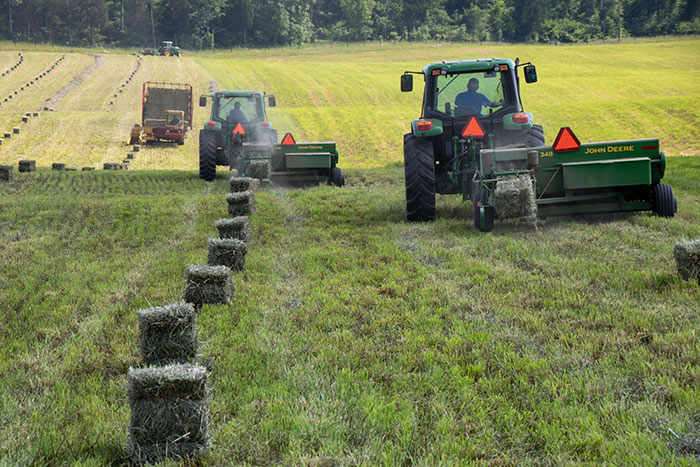
Let’s start with this: Depending on where you’re driving down the road, the vast majority of bales you see sitting in the field or in barns will either be of the large round or large square vintage. This has been true for a number of years.
Although many livestock producers have adapted feeding systems to accommodate large bale packages, there is still a significant market share that desire small square bales and are willing to pay a premium for the product. Last summer, we reported on a research study published in the Agronomy Journal that found small square bales sold, on average, for $105 more per ton than large round bales over a period of years at one Kentucky auction.
Ironically, it was labor, or lack thereof, that drove the industry to large bale packages, and it is labor that often drives people who desire the smaller square bales. In the latter case, it’s a matter of handling ability and convenience, and, as we all know, human beings are always willing to pay more for convenience. The success of the Roundup Ready trait, microwave ovens, and thousands of other products were built on that premise.
The U.S. Agricultural Census tells us that the number of hobby farms is growing. Add to these the larger equine operations, racetracks, small ruminant farms, and retail feed supply centers and you have the makings for a pretty stable (no pun intended in the case of equine) market for small square bales.
Next, consider that most hay producers just won’t mess with producing small square bales, which limits the supply. A consistent market and limited availability make for a potentially lucrative farm enterprise.
The technology of two- and three-tie small square balers hasn’t changed significantly in the past 30 years. That said, today’s serious small square bale producer, of which there are still many from east to west based on my travels, is no longer the keeper of flat racks, bale-kicker wagons, and hay elevators.
These days, technology now offers multiple options to collect and stack small square bales out of the field. There are even easy methods for loading flatbed and van semi-trailers without hand labor. It’s the handling innovations that have largely kept the small square bale industry viable for the producer and reduced the massive labor requirement of years gone by.
Some hay producers, who still prefer making large square bales, have invested in bale processors that slice and dice the big bales into small ones. Krone makes a baler that essentially does the same thing in the field. These technology investments are being made to expand buyer markets and capitalize on the higher premium for small square bales.
What’s the future?
Ed Nolt, a Pennsylvania Dutchman, invented the prototype small square baler back in the 1930s. His patent was purchased and mass produced during the 1940s. At the time, it was an instant hit on farms across the United States. This was largely due to labor and convenience; in other words, the same factors that brought large round and square balers into prominence.
Nolt’s brainchild made it easy to gather and bind dried forage and put it into a package that could be easily stacked. It was much better than manually picking up loose hay in the field, forking it onto a flat wagon, then hoisting it into the barn using large hooks and a pulley system.
The small square baler was a staple piece of equipment on farms for many years, but those days have come and gone. Not many young kids today will grow up knowing the methodic and rhythmic serenade of the baler as heard from the hayrack floor.
All is not lost, however.
With a premium market that appears stable and technologies that allow for the efficient handling and shipping of small square bales, the future of the two- and three-tie square baler and its user appears surprisingly bright.

